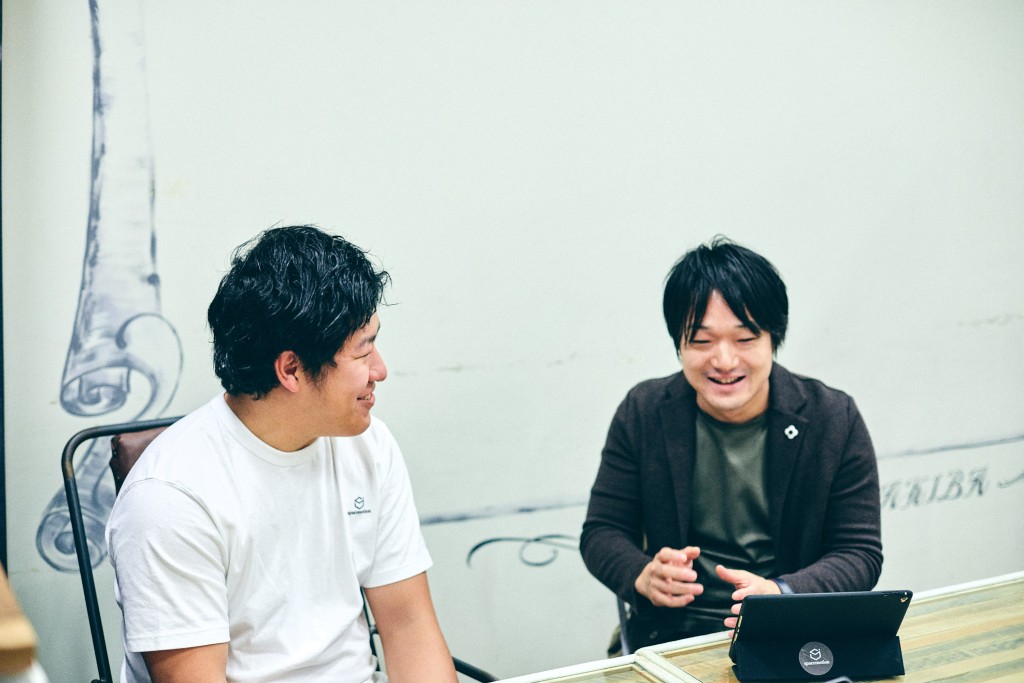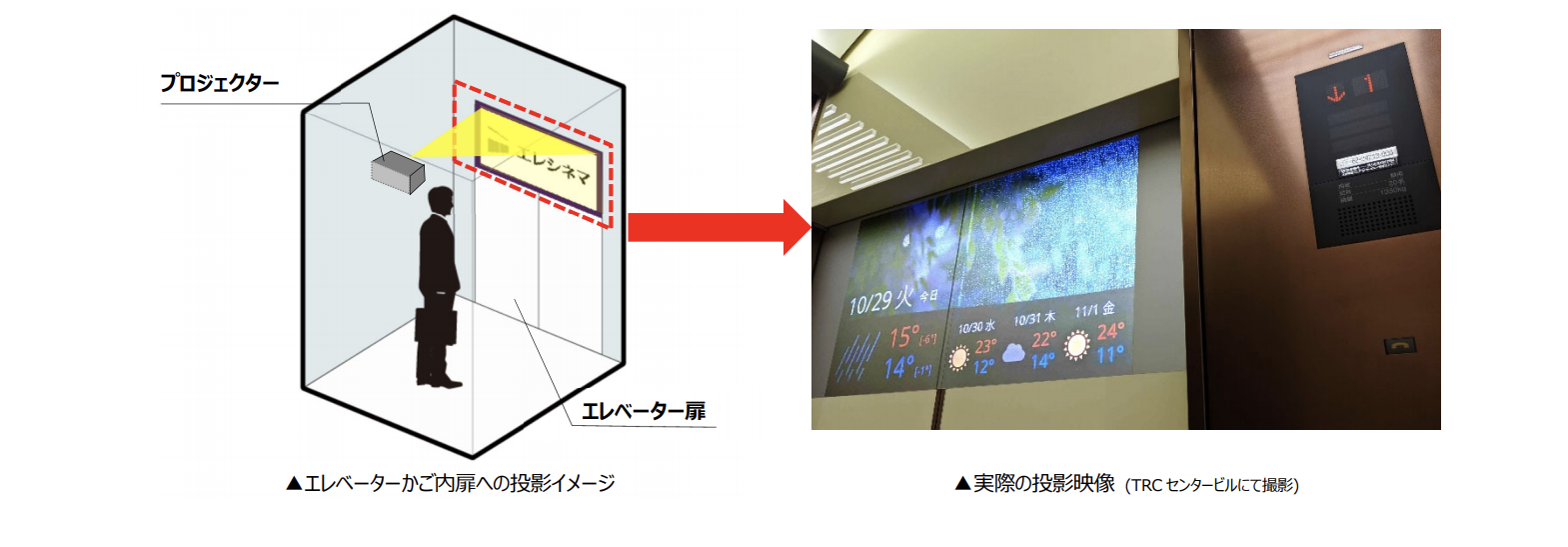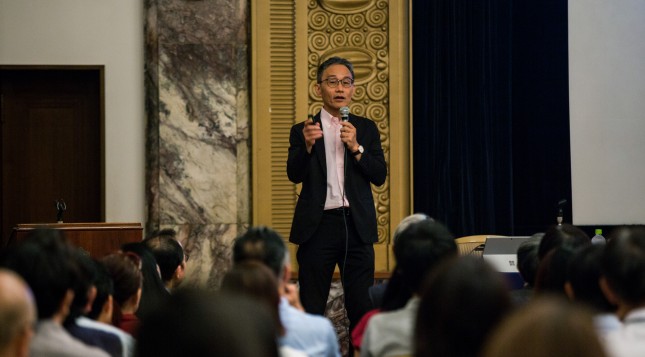Being willing to do analog work that requires steady endurance. Behind the launch of the business of media inside elevators, a rare event in Japan
Airbnb, Wework, and UberEats are now globally well-known.
All of them are startups that were born from complex regulated industries and are now creating new markets.
Mr. Ishii, president of spacemotion Co., Ltd., who talked to us this time, says, “It is the same challenge that we were trying to take on.”
He is launching an in-elevator projection media business in Japan, together with Tokyo Co., Ltd., which is led by Mr. Luo, Vice President. This project requires a steady and clear dialogue with the tangled and complex stakeholders in the real estate, elevator, and advertising industries.
This is how the projection-type “Elecinema” media was born.
Similar media are spreading explosively in China, and the interiors of elevators have been transformed into so-called “small theaters,” which are attracting attention as a new advertising method in Japan.
We first talked about the launch, which can be said to be a successful example of open innovation, and then about engaging in a bilateral business and productive compatibility in partnerships, as well as the potential of this business.
INDEX
・The possibility of products that utilize “gap time,” which permeates the lives of citizens of neighboring countries and of China
・Steady crudeness that makes use of advanced technology
・Creating value for elevator advertising as seen in the “stagnation point” theory
・Key Points

Kenichiro Ishii
After graduating from La Salle High School and the Faculty of Engineering at the University of Tokyo, he joined Mitsubishi Estate Co., Ltd. in 2008. After working in the Building Management Division, the Logistics Facility Division, Chinese Language Study Abroad Dispatch, and the Corporate Planning Department, he led the launch of the DX Promotion Department, a company-wide cross-functional department that promotes digital transformation. In November 2019, he established spacemotion Co., Ltd. jointly with the technology startup Tokyo Co., Ltd. and became its CEO. His hobbies include cycling and drinking sake.

Youhong Luo
He graduated from Rokko High School and the Faculty of Science at the University of Tokyo, and then enrolled in the Graduate School of Science at the University of Tokyo, but left without a diploma. While studying at the University of Tokyo, he established Tokyo Co., Ltd., which conducts research and develops technology specialized in the niche area of elevators. The origin of the company name is the title of one of the favorite songs of the founding members. His hobbies include cycling and drinking sake.
The possibility of products that utilize “gap time,” which permeates the lives of citizens of neighboring countries and of China

Ishii: When I was stationed in China, I came across a product similar to the Elecinema that we are developing. Elevator media, as well as small signage installed on toilet urinals, were scattered throughout the city.
The DX Promotion Department of Mitsubishi Estate, where I am still working concurrently (in addition to his obligations as CEO of spacemotion Co., Ltd.), also seeks to update existing areas by multiplying real assets and digital technology, so this business started with the idea of localizing and commercializing such products that “eliminate the gap time by utilizing the gap space.”
This field was an immature market in Japan, and was in a white space with no competition. Also, we determined that we would have a great competitive advantage, and this would become a very significant business for Mitsubishi Estate.
When considering the capabilities required for commercialization, we needed (1) a sales force targeting real estate owners, an understanding of the elevator industry and an advertising sales force, and (2) technology. For (1), we could use our own resources and know-how, but (2) had to be complemented by external partnerships.
Mr. Luo, who was a student at the time, was introduced to us by an investor.

Luo: Tokyo Co., Ltd., which I founded, was promoting the elevator media business beneath the surface at that time. Investors said, “I’ll introduce you, but I’ll leave it to you from that point on.” Suddenly, the emergence of major competitors made me wonder what I should do, but I wanted to learn the intentions of the major real estate company led by Mr. Ishii while keeping confidential important matters. In that sense, it was a very tense scene.
When I was a graduate student in science studying the Hayabusa 2 unmanned spacecraft, I unexpectedly saw notifications in other languages, of research fields that had nothing to do with me, posted on the elevator in the student building, so I felt the potential of the elevator business. I had some thoughts about so-called “advertising.” When I came to Tokyo, I thought that “advertisement in Tokyo is extremely self-assertive, and it’s not user-first.” This led to a desire to create a big impact through advertising.
This comparison occurred because, in my hometown of Kobe, Hankyu Railway places certain restrictions on advertising. Most of the advertisements are from the Takarazuka Revue and Hankyu Department Store, so the scenery inside the train is beautiful. That is still the ideal image of advertising to me.
I met Mr. Ishii at a time when I was about to bring the product to market, starting with technical verification for stable video distribution in elevators.
Ishii: The investors said, “Japan’s real estate and elevator industries have very complicated structures, and it’s an area that can’t be tackled by a startup alone, but it’s an area unique to Mitsubishi Estate, so it’s a business with great potential.”
In the beginning, as Mr. Luo said, there was mutual tension, but in February 2019, we had a lot of discussions and started to combine our strengths and move forward.
Luo: We had a relationship that couldn’t be understood from the outside, and we did several things, like distributing one-page brochures at an exchange meeting with hundreds of building owners [laughs].
Steady crudeness that makes use of advanced technology

Ishii: As I mentioned earlier, we lacked capabilities from the technology perspective, and it is quite difficult to stably deliver videos in a weak radio wave environment, such as an elevator.
Luo: Now, what is happening in China which is a precedent? It is said that the contents displayed in hundreds of thousands of video devices installed in taxis and elevators throughout China are replaced once a week manually using USBs by request. Due to the labor cost structure, this structure cannot be introduced directly in Japan.
Therefore, communication has to be completely controlled even in an elevator space where the communication environment is not perfect. In addition, in order to prepare for maintenance, we decided to conduct trial-and-error for three years, with dozens of units. Actually, when doing installations in elevators, every time we make a mistake, we apologize to the real estate owner and implement the PDCA cycle, which involves an endless time-consuming verification.
But basically, there is no demand for this technology [laughs], except for our company. We usually like things others don’t.

Ishii: I think there is a general image of what a startup is, but Mr. Luo and his colleagues are different. Even though it’s a startup of a group of engineers, they are doing something that is down to earth and crude. The same is true of technical verification, which has failed many times, but in the subsequent phase, we will jump into business with real estate owners and steadily achieve milestones in front of us to grow our business. In fact, the elevator industry has many stakeholders, such as real estate owners, elevator manufacturers, and maintenance companies, and the barriers are high. We want to break those barriers steadily, so I feel like I’ll be spanked if I don’t learn something every day [laughs]. It’s easy to say, but very difficult to do.
Luo: Even though we are a startup, sometimes we are asked “Why can’t you solve it with technology?” However, there are many things that technology alone can’t solve. I think the combination of digital and analog is important. There is no choice but to use analog in instances where digital can’t be used, and I think there are some personal characteristics.
My hobby is cycling, and I also like talking to people, so walk-in sales itself is not a problem. I often try things out before thinking, and then I do an abstraction after collecting data. When starting from abstraction, the hypothesis is often wrong, so I think it’s faster to think about the hypothesis while actually doing something. Even in walk-in sales, I was able to understand the patterns by doing it several times, to the point where I was able to determine where the owner was as soon as I entered a building [laughs].
What I often use as an internal slogan is “How to make a product that customers will choose?” However, only the customer can know the answer, so I think we have to increase the n-value anyway.
Ishii: We are aiming for goodness in all directions, but we are also actively trying to find out if those directions are truly “good.”
Luo: People don’t reveal their true intentions face to face. That’s why, in the thorough research that we conduct to interpret the financial statements of other companies, there are quite a few cases where we search for their “pain points” and then try to test our hypothesis a considerable number of times.
Creating value for elevator advertising as seen in the “stagnation point” theory

Luo: Basing on the fact that the size of a similar market in China, which is a digitally advanced country, has reached about 5 trillion yen, the expected market in Japan is at least 200 billion yen. Looking at the trend in advertising, it is said that advertising on TV, which is regarded as a means of mass advertising, will fall below the previous year for the first time this year and will continue to decline. In Japan, the fields of taxi and outdoor advertising are drawing considerable attention.
One reason Elecinema shows a certain value is that the elevator is a “stagnation point” [in fluid mechanics, this is the point where waves collide and become zero]—the point where you are standing still by yourself in a building, and the travel time is very short, which is why you can’t choose an escape like your smartphone.
Ishii: I often observe what people in elevators are doing because of my work, and about one or two out of 10 people are checking their smartphones. Usually, people look at the display of floor numbers.
According to the stagnation point theory, it is not good to be too stagnant. For example, when you are standing on a train, you look at the train channel, but when you sit down, you don’t look at it. The same is true for taxis; there, people watch tablet ads for a while after boarding, but after a certain period, they move on to other actions. In that sense, the elevator is a good place with a high gaze rate.
Some people think that the short time of riding in an elevator is a disadvantage; however, information redundancy in this day and age, which isn’t useful because of information overload, tends to be increasingly disliked. Instead, that the content can be watched efficiently because it is of short duration is our selling point, and our content is also optimized for that space.

Luo: Of course, the source of income for the content we project is advertising. Besides that, there is also a framework for things that the real estate owner wants each tenant to know and tools for management, such as notifications of facility inspections including power outages in the building and of the nearest evacuation center, as well as a framework for streaming content for users to kill time such as news, weather forecasts, and restaurant information.
There are benefits not only for real estate owners but also for users and advertisers. Establishing this as a business will be good from all perspective.
If I wanted to sell Elecinema as a product, it would totally sell, but I am daring to expand it with an advertising model. I emphasize this because I think that providing for free something that could be sold is a value that a startup can offer. It is often said that one has to be 10 times better than others at doing something or offer something at 1/10th the price. If you don’t offer one of these aspects, the startup won’t succeed. We are taking the challenge there.
Key Points
・ Media in elevators is attracting attention as a new advertising method in Japan.
・ The idea was born as they started thinking about whether they could localize and commercialize a product that “utilizes the gap space to eliminate gap time.”
・ What was needed was a sales force targeting real estate owners, an understanding of the elevator industry, an advertising sales force, and then technology.
・ In the verification phase, the PDCA cycle was repeated by actually installing devices in elevators.
・ There are many things that cannot be solved by using technology alone.
・ What is important is how to make a product that customers will choose.
・ The “stagnation point” (in fluid mechanics, the point where waves collide with each other and become zero) in elevators is an opportunity.




 Mitsubishi Estate
Mitsubishi Estate 






